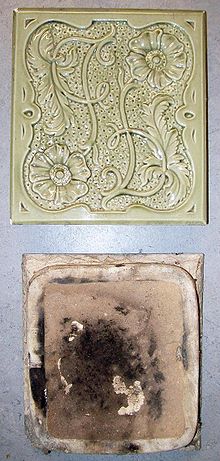Stove tile
Oven tiles are the eponymous components of the tiled stove . Like other ceramic tiles, they are made of baked clay. Due to their weight and heat capacity, stove tiles store thermal energy even after the stove fire has gone out. Glazed stove tiles are easy to clean and often served a decorative function.
Types of stove tiles
A basic distinction must be made between simple tiles or vessel tiles and composite tiles.
The simple tiles / vessel tiles include:
- Mug tiles
- Tube tiles
- Pot tiles
- Bowl tiles
- Bowl tiles
The composite tiles, which consist of a separately manufactured (modeled) face side and an attached part, include:
- Mushroom tiles
- Plate tiles
- Niche tiles
- Half cylinder tiles
- Leaf tiles
- Leaf bowl tiles
- Corner tiles
- Cornice tiles
- Wreath tiles
- Crown tiles
There are also other ceramic components, such as B.
- Stove attachments / cornice tiles
- Inguinal tiles
- Furnace feet
- Oven columns
Production and processing of stove tiles in the 19th and 20th centuries century
Since the late 19th century, stove tiles have often been poured from clay slip lined with fireclay , dried and scalded ( pre-fired ). They are then poured with glaze paint on the outside or painted and burned smooth.
Web or hull tiles have a trunk (also tube or frame) connected to the furnace to the furnace interior (firing) towards clay , Stopfsteinen and more recently with fireclay was filled ™ stones. Roof tile fragments or stones could be inserted between the tubes for alignment and as spacers. Often the tiles were also stapled or wired together with wire in order to ensure better stability of the ovens. These processes are called extrusion and entanglement. The tiles had a hole at the top and bottom of the frame for entanglement.
In addition to the cast bridge or trunk tile, there is also the so-called "full tile". This is a five centimeter thick tile that is shaped (mostly by hand) and is more stable due to its shape. When moving these tiles, the furnace builder saves the need for shelling and entangling, as they have a correspondingly higher structural stability due to their thickness.
use
Tiles make up a large proportion of the mass of tiled stoves and therefore contribute significantly to heat storage. Regardless of their color and shape, they have a high degree of absorption in the mid- infrared , which means that sufficient heat radiation occurs even at the relatively low temperatures of a tiled stove.
Due to the radiant heat given off, the room temperature in a room heated with a tiled stove can be kept lower than when heated with convectors, while maintaining the same level of comfort .
Tiles similar to the forms used for furnace construction are occasionally used as decorative wall cladding. Owing to the open porosity of the body and the partially cracked glaze, stove tiles are usually not frost-proof. Tiles are therefore used for decorative outdoor applications .
literature
- Eva Roth Heege: Oven ceramics and tiled stoves - typology, terminology and reconstruction in German-speaking countries (CH, D, A, FL) with a glossary in seventeen languages. With contributions by Monika Dittmar, Julia Hallenkamp-Lumpe, Andreas Heege, Matthias Henkel, Klaus Hufnagel, Uwe Lamke, Katja Lesny, Margret Ribbert, Harald Rosmanitz and Günther Unteidig. Swiss contributions to the cultural history and archeology of the Middle Ages, vol. 39. Verlag Schweizerischer Burgenverein, Basel. ISBN 978-3-908182-23-8 .
- Cologne stove tiles. The holdings of the Museum of Applied Art and the Cologne City Museum, edited by Ingeborg Unger, with a contribution by David Gaimster, Locher GmbH, Cologne 1988, ISBN 3-927396-01-X (important material template ).


